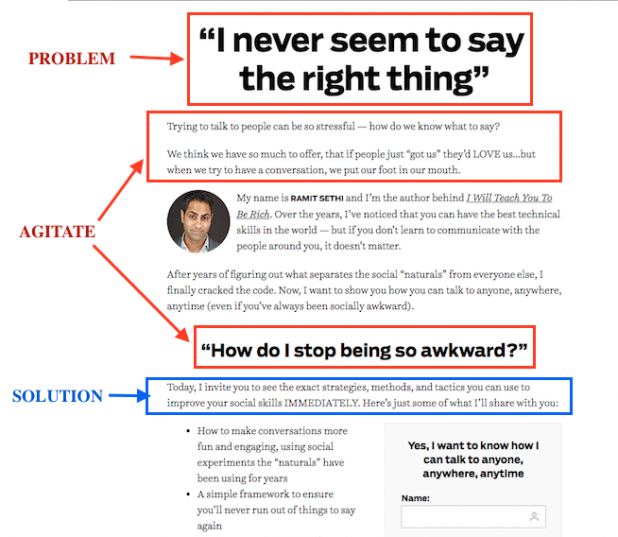Have you ever felt like content creation is an uphill battle?
Not getting the likes, shares and comments you should be?
Having a hard time increasing click-through rates in your emails, or conversions on your landing pages?
If so, then this proven conversion framework will help you out.
In fact, if you want to improve any piece of communication intended to get people to take action, this framework will give you the structure and sequence you need to get your desired result.
It’s called the PAS framework and once you have finished this post you’ll have a proven method for communicating genuinely and powerfully with your audience, and driving them to take action – without needing to be a killer copywriter.
The PAS Framework is as Easy as 1-2-3
PAS stands for Problem-Agitate-Solution and it is one of the most commonly-used frameworks for structuring persuasive messages.
One of the reasons it works so well is that it is market-centric. What this means is that it forces you to think from the perspective of your audience. You have to put yourself in the shoes of your readers and meet them where they are.
One of the most powerful ways to do this is to talk about a problem they are having.
1. Call out your reader’s problem
The first part is the easiest. All you have to do is define the problem for your readers. Of course, this assumes you have done your research and you know exactly what problems your market is struggling to solve.
The most important aspect of this first step is to state the problem simply, clearly, and in straightforward terms. This captures your readers’ attention and draws them into your message.
At this beginning point your argument should be logical and factual, and once you have established the problem, you transition into the emotional agitation step.
This is where the real magic happens.
2. Agitate the problem by getting specific
The agitate step is where you dig into the nitty-gritty details of the problem, unpacking all the ways the problem is impacting your audience’s lives negatively.
Make sure you give the problem dimension. Give it size, shape, color, smell, talk about the negative effects on your reader’s life, and acknowledge the emotional strain they’re experiencing.
Interestingly enough, even though this step is the most effective part of the PAS framework, it is also the part a lot of copywriters and marketers overlook. They do a good job of calling out target audience and outlining the problem, but they often don’t do nearly enough agitation.
This is not to say that stating a problem and offering a solution doesn’t work. It’s just that the agitation step is an opportunity to frame yourself and your solution in an exceptionally compelling way.
I’ll discuss more about how this works in a moment, but for now know that the agitation step all about stimulating emotions, which is how you drive action towards your solution.
3. Offer your particular solution
Once you have stated the problem, established its negative effects on the lives of your audience, making sure to hit the emotional pain points, it’s time to offer up some relief.
It’s at this point where you present your solution, and if you have done a good job of the first two steps, your solution will seem like the most obvious one for solving your readers’ particular problem.
Simply put, the PAS framework is about creating a context for your readers to think about their problem, and then framing your solution as the best way to solve it.
As I’ve already mentioned, it’s one of the most reliable persuasion formulas ever invented.
Here are a few reasons why…
Why is the PAS Framework So Effective?
Most of the time people are much more likely to act to avoid pain than to go after a benefit. This is psychology 101.
In his book 80/20 Sales and Marketing online marketer extraordinaire, Perry Marshall, states that a message talking about problems can deliver between 3 and 10 times the response than those that talk about the company or the product.
He says the effectiveness of the PAS framework for getting people to take action is based on the fact that when you talk about problems, you are in a sense “reading people a page from their own diary”, tapping into core emotional drivers.
If someone has a problem that persistently bugs them, chances are they think about it a lot, most of the time in negative terms. When you call out your readers’ problem, you’re actually capturing and directing their attention towards the problem, which lays the groundwork for your solution.
Agitation: The Secret Sauce That Makes PAS Work
Once you have your readers’ attention, going into details about the problem – the agitation step – is the most efficient way to do three vitally important things.
First, it gives you the opportunity to demonstrate that you feel your readers’ pain. You’ve been where they are, and doesn’t it suck to be there? It also shows your reader that you’re not afraid to talk about some pretty uncomfortable emotions and bring them to the surface.
Empathizing with your reader like this is one of the fastest and most reliable ways to build trust.
Second, when you talk about a problem, and describe it in detail, it shows that you understand where your reader is at, rather than just telling them “I feel your pain”.
Finally, describing a problem in detail further demonstrates that you have thought about the problem a lot too, and because you clearly understand it so well, you must have thought of a solution.
This subtly positions you as the expert because of how you give the problem dimension.
As one famous old-school marketer put it, “If you can describe someone else’s problem better than they can, they will automatically assume you have the solution to that problem”.
Fascinating, right?
It’s also incredibly powerful stuff. And it’s why the “agitation” part of the PAS framework is so critical.
It gives your audience a context in which to think about their situation, which in turn gives you the opportunity to frame your product or service as the perfect solution for them.
How PAS Uses the Power of Structure
Another reason the PAS framework is so effective is because it follows the classic “beginning-middle-end” structure of stories. PAS typically starts in a negative place, moving on to making the problem feel even worse, and then goes to a positive place, providing relief from the pain of the problem, as well as a healthy dose of psychological satisfaction inherent in completion.
For example, “rags to riches” stories follow the PAS framework. A guy (or girl) starts out with nothing (problem), tries to get ahead in life, but fails multiple times (agitation), and finally triumphs, usually with the help of a mentor, or a technique, a realization, or a “secret” (solution).
What is important to notice about this structure is that it is all about movement.
When the framework is used properly, this movement takes the reader from a place where they don’t want to be towards a desired outcome. And that desired outcome usually requires the reader to take some form of action.
The PAS Framework Applied
Here are a few examples from different media and markets I’ve used to illustrate exactly how you can apply PAS to your content marketing.
1. The first example is a classic from direct response adverting legend, Maxwell Sackheim:
The problem is in the headline, and it speaks to an insecurity many people had (and probably still have) about how they speak and write English.
After calling out the problem and establishing the author’s credentials, Sackheim really goes deep into the tricky, uncomfortable emotions behind the problem.
The detail is what makes it effective, and it also makes the transition into the solution feel almost seamless.
2. Here’s a more contemporary example from Ramit Sethi:
The exact same PAS framework is being used here, but in a shorter form – a landing page.
Again, the problem is in the headline. The headline is also in quotes, which suggests this is a thought the target audience is currently having (or has had before).
The agitation step here is quite short, but still effective. Depending on the media you are using, it is sometimes not possible (or it just doesn’t make sense) to go into a long, drawn out agitation of the problem.
Also, your audience’s level of awareness of the problem can impact on how deeply you want to flesh out the details. Sometimes you can get straight to the point and still be highly effective, like Ramit is in this example.
3. This last one is from content marketing master Jon Morrow:
Just to show you that you can use the PAS framework in virtually any context, this is an example of PAS used in a more dynamic way. Here PAS is being combined with a classic blogging formula, but with a twist, in typical Morrow style.
The main aim of the framework here is to get people to read further, but there is still a clear application of the basic steps, with a creative angle and framing of the “solution” (what NOT to do if you want to be a popular blogger).
The key takeaway from these examples is that each one is urging the reader to take some kind of action – whether it is to send away for a free book, opt in to an email list, or simply to read on.
How You Can Use PAS to Increase Engagement, Clicks and Conversions
Hopefully by now you have a good understanding of the PAS framework and have some ideas about how you can use it in your own content marketing pieces.
You have also seen that because it is based on proven psychological triggers, it is simple to apply, so you don’t need to be a killer copywriter to make it work.
The PAS framework can also be used in virtually any context, in any market, with any media – as you have seen from the examples above.
The framework is about driving action, so it is perfect for getting people to click, share, or engage in some kind of activity that moves them closer to making a buying decision. Use it for driving clicks on PPC ads, shares on social media, or for drawing readers into a blog post or article.
The “beginning-middle-end” story structure is perfect for emails and encouraging subscribers to click through to get their solution. And for longer marketing pieces like case studies and white papers, you can’t go wrong using PAS.
Ok, now it’s your turn.
Where can you apply the PAS framework to your content marketing pieces today, to boost engagement, click-through rates, and conversions?







